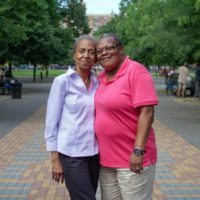Queer Love in Color
Share
Explore Our Galleries
Breaking News!
Today's news and culture by Black and other reporters in the Black and mainstream media.
Ways to Support ABHM?
By Jamal Jordan, The New York Times
Why do no gay people look like me? Jamal Jordan, a black digital editor at The Times, lamented growing up. So as an adult, he decided to give a gift to his younger self: the imagery of queer love.

Paulette Thomas-Martin and Pat Martin live together in Harlem. They are both 66 and have 13 grandchildren between them from the lives they lived before they met.
Credit
Jamal Jordan/The New York Times
As a child, I thought all gay people were white.
By the time I was 18 and living in Detroit, being gay was no longer a “problem” for me. I was out of the closet, and my family and friends were supportive, even encouraging. Yet, as I set off for college, and grew more comfortable calling myself an adult, a man — a gay black man — I was convinced that no one would ever date or love me.

Cyree, left, and Azure, both late for appointments, outside of their home in Brooklyn.
Credit
Jamal Jordan/The New York Times
Growing up, I had rarely seen queer characters of color in the gay young adult books I read, in episodes of “Queer as Folk” I watched or issues of “XY” or “Out” magazines I stealthily bought at Barnes & Noble.
I spent most of my teenage years believing that love between two black men wasn’t even possible. To my queer white peers, an entire world of change was unfolding: Public support for same-gender marriage eventually led to its legalization nationwide, and queer people were appearing as the leads in more TV shows than I could ever watch. People even won Oscars for directing movies about gay white cowboys….
Despite taking the time to learn to love myself, building the courage to drape myself in a body-length rainbow flag and march in the Pride parade, I still didn’t know what it would look like — feel like — to receive love from someone who looks like me….
As a visual journalist, I believe pictures can connect with people in a way that other forms of media can’t. To this end, I decided to give a gift to my younger self: the imagery of queer love I’ve never seen. Queer love in color.
Read the full article here.
Read more Breaking News here.









Comments Are Welcome
Note: We moderate submissions in order to create a space for meaningful dialogue, a space where museum visitors – adults and youth –– can exchange informed, thoughtful, and relevant comments that add value to our exhibits.
Racial slurs, personal attacks, obscenity, profanity, and SHOUTING do not meet the above standard. Such comments are posted in the exhibit Hateful Speech. Commercial promotions, impersonations, and incoherent comments likewise fail to meet our goals, so will not be posted. Submissions longer than 120 words will be shortened.
See our full Comments Policy here.